Until recently our only access to the internet when out of range of cellular networks, has been using our Iridium GO! Even then, our communication with the rest of the world has been limited to laggy telephone calls, SMS text messages, text-only emails and weather GRIB files. This is not REAL INTERNET!
An increasingly common solution now is to install Space X’s Starlink which relies on low orbit satellites to provide broadband-busting download speeds anywhere (almost) in the world. Starlink offers two different types of hardware: the normal land-based version and the maritime version.
Starlink’s maritime solution
The maritime hardware promises global maritime coverage, with download speeds of up to 220Mbps. This might sound tempting but the costs are high. You are looking to pay at least $2,500 for the hardware plus service fees ranging from $250 – $1000 (USD) per month. Either option here is significantly too expensive for us, and is firmly out of reach for most of the cruisers we’ve ever met.
Starlink’s land based solution
The normal version is far more reasonably priced. The satellite dish (affectionaltely called dishy) and router should set you back around $500 USD; with regional offers available from time-to-time. In Canada, for example, we snapped up ours on wile it was on offer at $350 CA (about half of normal price). The monthly service fees will be around $100 for a fixed address, or $150 for the Roam (previously branded RV) package which allows the device to be used from a recreational vehicle. The standard Roam package is called Roam regional, and is limited to the continent you register it in – for truly global use you can pay a little more for the Roam global package. For the rest of this article when I refer to Roam, I am talking about Roam regional.
Whichever you choose, you have an option to suspend or change the contract on a monthly basis (the latter is said to be more difficult and the option availability on the Starlink app has recently undergone some alterations).
Prices vary significantly between countries so it might be worth waiting to buy when you reach a certain destination. For example: our Canadian Roam service costs us $124 US a month, the same US based Roam service is $150 US, and in Mexico Roam service would cost the equivalent of just $79 US.
Roam packages offer a priorty data variant too. In areas with intense usage, priority data contracts will have – guess what – priority.
The hardware you get for fixed installations and for mobile use is identical. Starlink notes that this hardare is intended for land use only. Nevertheless, Starlink Roam is currently used on countless yachts. Be aware that there is a limitation: Roam officially is for stationary use only. Service may not be avaiable if you use it while traveling at OVER 10 mph. This speed limit doesn’t bother us much when we’re sailing.
According to Starlink’s terms of service, use at sea can be denied via geofencing, which means that you might be denied internet access when they detect you are no longer conected from a location on land. Starlink’s website has a service availability map. Zooming in on the map, colored hexagons (15 miles across) indicate what service is available in any given location. What Starlink considers to be land is shown in blue, and black hexagons are used to indicate sea.
As you can see in this screenshot, most of the sea area around Vancouver is in fact land according to Starlink. There are just a few small areas where black hexagons are shown:
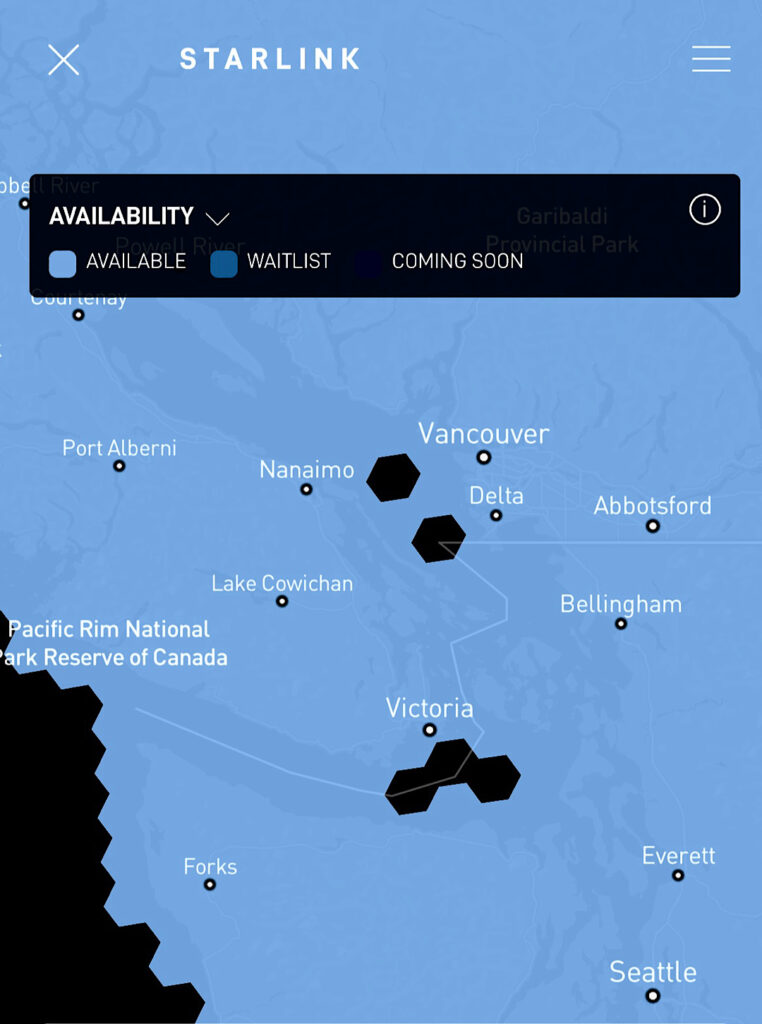
When sailing the fjords of British Columbia we were regularly without a cellular network coverage, and Starlink was the only realistic option to have full internet on board. Luckily, most of this area is covered by the blue hexagons.
Remember: according to Starlink, blue means you’re sailing on land and have data coverage with Roam. If you sail through a black hexagon you are at sea and will not be able to surf the internet during this period. For example, in the above screenshot this might be the case when crossing from Vancouver to Nanaimo.
How to use Starlink at sea
There are two reasonable solutions for cruisers who want to use Starlink to access the internet when transiting an area designated as at sea:
Switch to the Maritime Mobility plan
Starlink offers another maraitme plan: Maritime Mobility 50 GB. This permits use on land and also on the ocean and, unlike the normal regional or global Roam, also offers the same priority (and therefore potentially higher speed) as the land-based fixed version. Prices are significantly higher though at: around €224 USD per month, and downloads are limited to 50Gb. Once you have used up your allowance, you remain with unlimited (but not priority) data volume on land; at sea you can top up for $2 per Gb.
Stay with Roam and simply top up
This is what we do! Yes, Starlink may have blocked your internet access while at sea, but you’re still connected to them; allowing you to change plan or make other purchases. Whenever you find yourself inside one of the black hexagons, you can use the Starlink app to open your account settings turn on mobile priority.
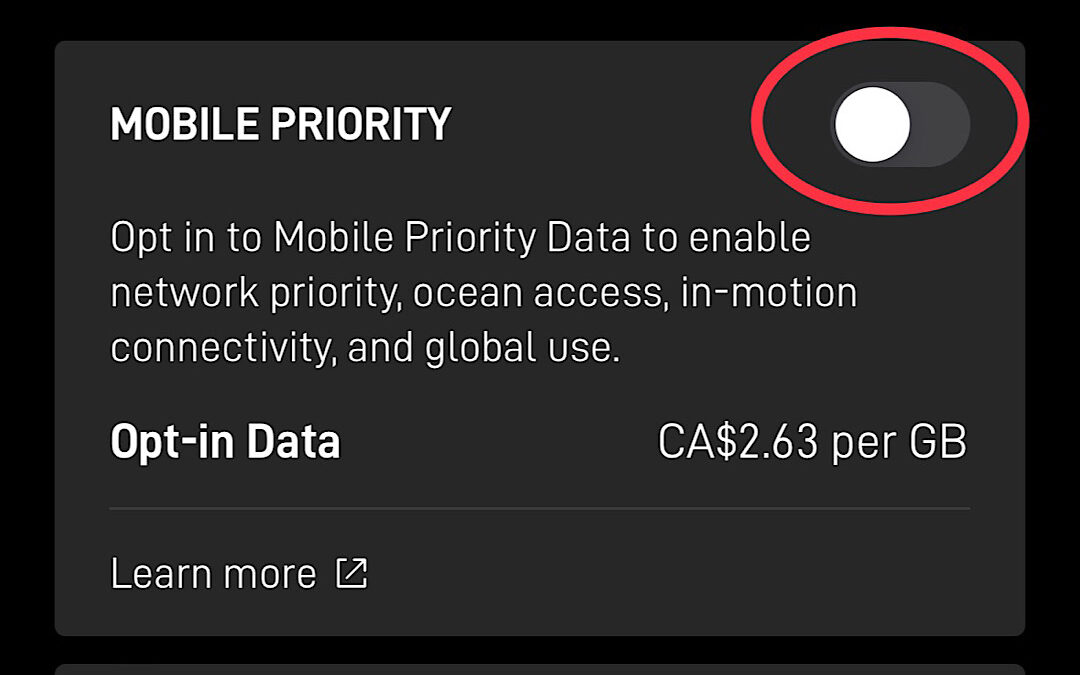
This will allow you to access the internet on the move and even during an ocean passage. You pay $2.00 per Gb of data while this setting is active. Just don’t forget to turn of again when you reach a land hexagon or you will still be charged for using priority data there too.
Dealing with drop-outs
A quick note on what to do if your Starlink loses connectivity while you are underway. Remember that the RV dish was designed for use on the road, not at sea, so it’s possible that the motion of your boat will sometimes cause the signal to drop out and you may be left with no internet access. If this should happen, the one thing you should not do is use the STOW/UNSTOW menus. These are meant to be used if you are putting Dishy back in its box and will cause the motors to angle Dishy’s “leg” in a stowage position. When unstowing, Dishy will use its motors to scan the sky looking for satellites. This needs to be done from a stable base (perhaps at anchor) and is likely to fail if you are in a big sea. Your best bet is to manually angle the dish, or to slow the boat down to ease the rolling.
Setting it up
So how about the installation? It really is just Plug and Play, and couldn’t be simpler to get up and running. To explain, just take a look at the photo of the COMPLETE INSTALLATION INSTRUCTIONS:

Plug the dish into the router, then plug the router into an AC power supply (either 110v @60Hz or 230v @50Hz will work). Connect your phone to the router’s WiFi network, and open the Starlink app to get online.
Power supply and consumption
Starlink do not offer a 12v power adapter, so a direct connection to the ships 12 volt system requires modifications to the Starlink hardware, invalidating its warranty. Rather than risking our warranty, we prefer to accept the energy losses incurred using our inverter.
Starlink is power hungy. While in use, expect to see 6-7 amps being drawn from a 12v battery bank. It therefore may be wise not run Starlink permanently. Unless we are on shore power, we switch it off whenever it is not in use.
Mounting Dishy
Even with a makeshift installation with the antenna on the floor of our cockpit, under the sprayhood and boom, and with all the other masts around us in the harbor, we had good reception and could reach download speeds of around 50Mbps. This got even better, when we mounted Dishy on our stern and were out at anchor with nothing to obsctruct our view of the sky.
We have now permanently attached Dishy to Flora’s stern using a fishing rod holder. The Dishy pole was slightly padded for a firmer fit and secured by a rubberized hose clamp with a lanyard lashed to the pushpit:
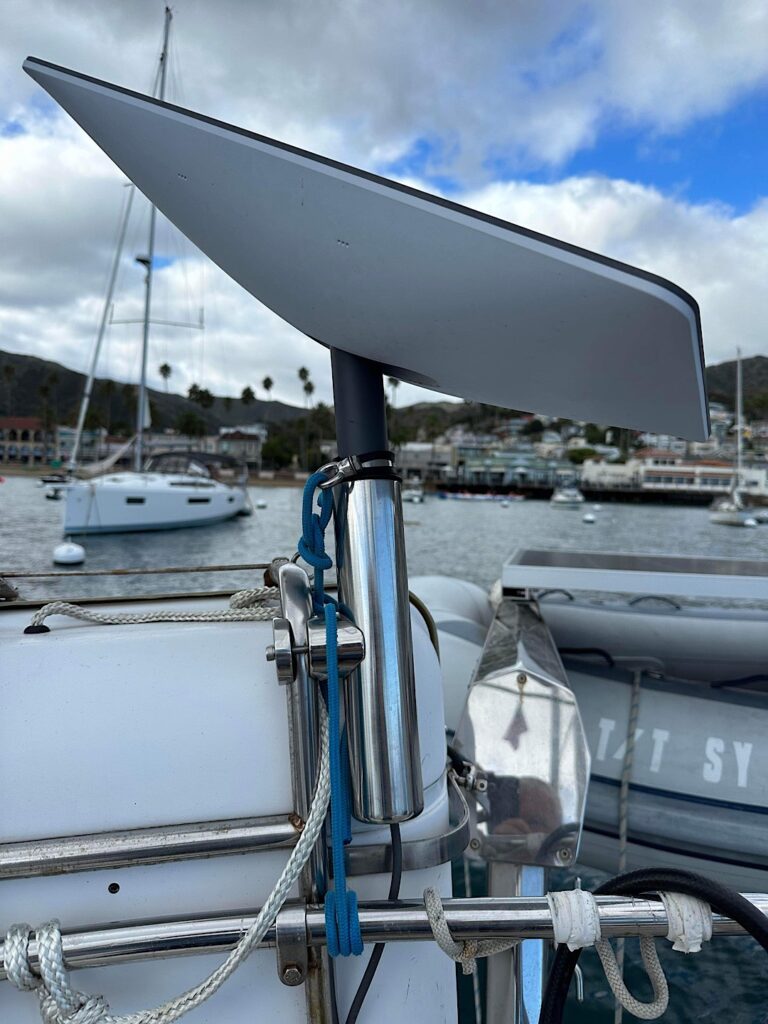
This setup has now proven itself at sea and has survived passages from Canada, along the US West Coast and all the way down to Mexico.
How does it compare?
Starlink is difficult to compare with other means of communication for yachts on the high seas.
The price for installing a SSB radio is higher than Starlink, and has the added complixity of ground plates and operator licenses. SSB costs are of course amortized over time, as once installed it is essentially free to use, but it is by no means cheaper for a shorter trip like an Atlantic circuit, for example.
Iridium, another popular choice, is a much older technology that simply cannot compete with the connection speeds offered by Starlink; even their newest devices don’t come close. Our Iridium GO!, for example, has a data transfer speed of just 2.4Kbps (yes it’s measured in kilobits per second not megabits!). What they do offer though is robustenss and portability. It is not possible to take your Starlink ashore when hiking in a remote spot. Or, perhaps more significantly, into a liferaft if the worst should ever happen.
In short, the service offered by Starlink is still very unique. If offshore comms were only about getting weather GRIBs, then fine, but the communication requirements of many long-distance cruisers now seem to go way beyond that. Its sheer speed and simplicity make Starlink a very tempting proposition for many. Until Amazon’s project Kuiper is available, Starlink is in a league of its own.
In the meantime, if you really want to stream Netflix mid-ocean (not saying you should), then you know what you need to get!
One device to rule them all?
So did we throw away our Iridium GO! already? In a word: NO.
Our Starlink has been working well, even when sailing offshore. However, it is not perfect. We heard an account of a boat losing reception when it left the US east coast, only to regain it again when it reached the Bahamas. Other yachts have reported problems rebooting their routers when they are not in a quiet anchorage or harbor.
As long distance sailors, we love reliability and having backups for everything, so our Iridium GO! reamins in service for now!
For may sailors, communication via SSB has been superceded by Iridium GO, with fewer and fewer sailors having shortwave radio on board. In this respect, Starlink seems to simply be the next logical step. The sense of isolation on an ocean passage might be lessened as a result of installing Starlink, but wasn’t that the case when SSB and Iridium were introduced too? The level of impact from this change lies ultimately with how the crew of the boat decides to employ their new toy, and indeed whether or not they even want that sense of isolation at all. Either way, Starlink gives us the choice, and surely that’s a good thing?

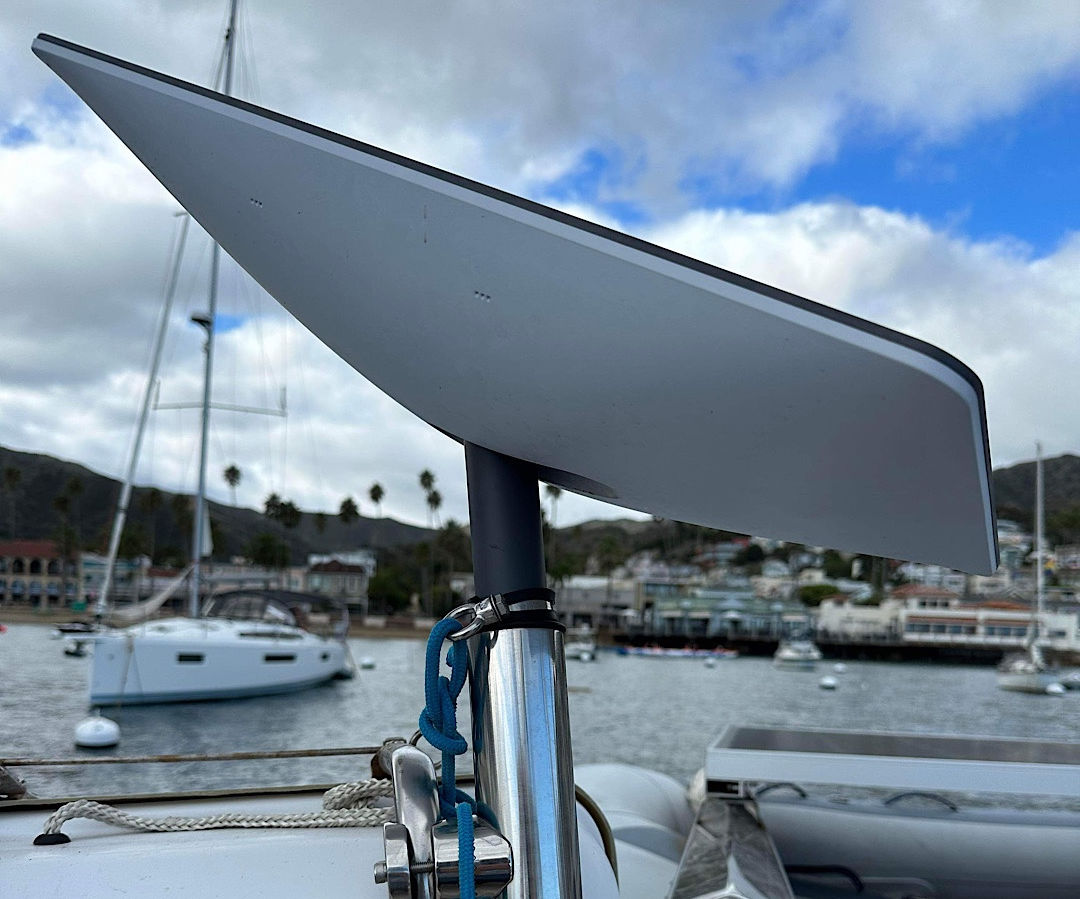




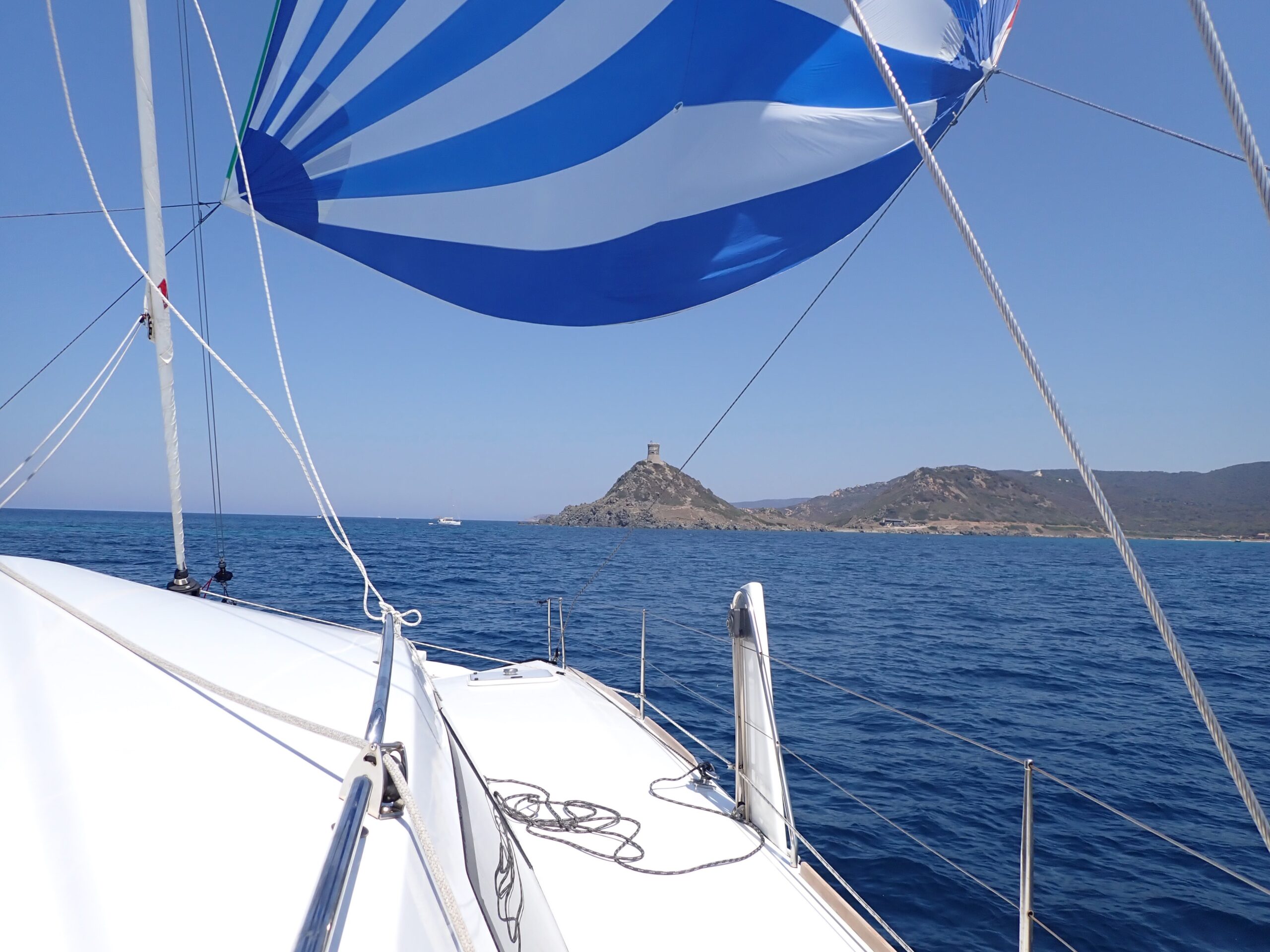
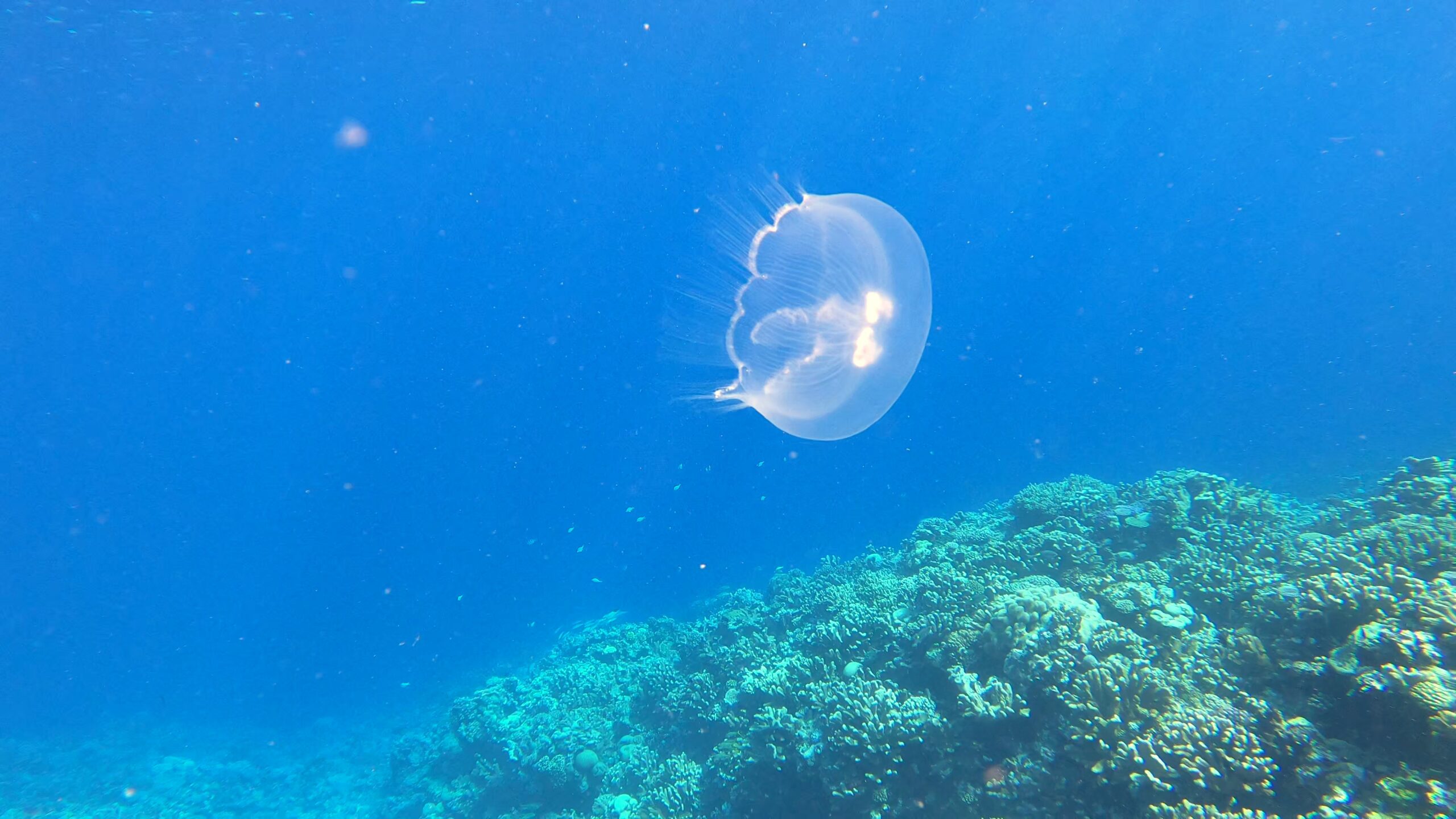
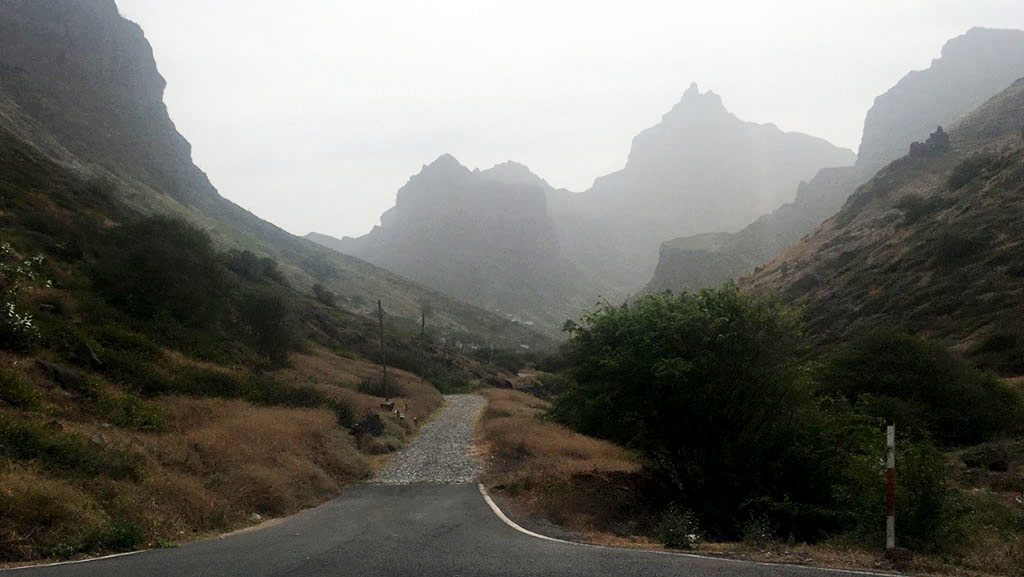
Thanks for the Starlink article . Enjoyed the cruiser details. We will fit SL to HOPE soon.
As someone who has been enjoying the benefits of Starlink aboard for almost a year I enjoyed reading your article. I do want to point out one error: once you are in a “black hexagon” you are unable to toggle the offshore/priority data on. You will it have access to your Starlink account or the internet. This must be done BEFORE leaving. We learned this the hard way on our passage from New Zealand to New Caledonia. We had to use our IridiumGO to email a family member back in the USA to log on to our Starlink account and enable the offshore option.
Brian, I donˋt know why it shouldn’t be working for you, maybe that’s just a problem of your version? It definitely worked for me, being on (northern American Mobile Regional). I’ve switched the Mobile Priority switch on while I was in a black hexagon several time, last time just today. Off the coast of Mexiko starlink told me it was found in an “unexpected location” (out at sea) and sure enough my internet didn’t work anymore. Switched the slider, waited about 10 minutes and: connection restored, internet worked again (while still in a black hexagon).
That’s strange, because in our experience sailing around Australia using the regular Roam service (was RV when we bought it) when we loose Internet connectivity of the standard service due to being outside the land area we are still able to access our account via the Starlink app and toggle ON priority data. Internet service is restored within a couple of minutes.
Thank you very much. Great article.
Currently (!!) boats sailing from Europe to Americas experience problems as the Regional subscription does not cover another continent so after few hundred miles it stops working. To prevent this one needs to switch from the Regional plan (approx €100) to the Global plan (approx €250) before the crossing. The mobile priority opt in (pay per GB) on the regional plan only works (at the moment) on the water in your continent (despite it stating ‘global’). Once arrived do as stated above, delete your subscription and create a new one to benefit from the lower costing regional plans (and opt in whenever you are in a blue hexagon).
Danke für den tollen und informativen Artikel.
Als Ergänzung möchte ich noch anmerken, dass die neueren Iphone Modelle im Notfall auch eine Satellitenverbindung aufbauen können.
—
Thanks for the great and informative article.
As an addition, I would like to add that the newer iPhone models can also set up a satellite connection in an emergency.
I am just about to purchase Starlink and I have a question. Our Boat is currently in Greece and I have been cursing in the Med for two years. I am from Southern California and fly home for the winter, where I am at currently. My question is, should I purchase Starlink in California, and take it to the Med. and install it on my boat there ? Or should I purchase it in the Med.? Keep in mind we are crossing to the Caribbean in Dec 24, and we will be staying there, and going up the west coast of US.
Thanks For you help
Robert Ahlke
Wherever you buy it, if you use the regional package you’ll need to re-register it to use in the Americas after you’ve crossed the Atlantic. It’s significantly cheapter to buy SL in Greece than in the USA at the moment (450 EUR vs 600 USD for the unit, plus 100 EUR vs 150 USD per month for service). You can check prices in different parts of the world by entering a shipping address on the SL web site. If I were you, I’d buy it and have it shipped to your boat in Greece – it’ll also save you carrying a big box out to wherever you are moored.
In addition to the reply of Simon: there are some price comparisons available on the web for a first overview, I.e. https://extensia-ltd.com/2023/10/31/compared-starlink-prices-around-the-world-including-africa/
You have to make two choices: where to buy and which service to choose. It all depends on your estimated usage. Have you been fine with cell service in the med or do you also want to use Starlink during your Med passage? In that case, it would be Mobile Regional (=continent, in this case Europe) first and then Mobile Global for the Atlantic crossing (+switch on Mobile Priority). As Simon already suggested, you might want to change (back) to Mobile Regional (North America, incl. most of the Caribbean) once you did the crossing.